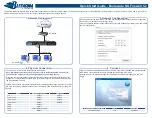
ABOUT THE TRXMIM FAMILY
Page 1-8
1 . 2 . 4 S u p p o r t f o r P a s s i v e M A U W o r k g r o u p s
Whereas a station signals a TCU to open its interface by sending a
phantom current down its lobe cable, a passive MAU can not
provide phantom current. A TCU Ring Out port is therefore
configured to ignore the absence of phantom current in the
connecting cable and to look instead for the presence of data bits to
determine link status.
By default, each of the TRXMIM’s TCU ports is configured to its
STN (station) setting to support concentrator lobe connections to
stations. Through Local Management, any TCU port may be
reconfigured to its RO (Ring Out) setting to support connections to
passive MAU (Multi-Station Access Unit) workgroups.
Note:
The output of the TRXMIM’s LANVIEW LEDs for a Ring Out
port is quite different from the output for a station lobe port. See Section
4.2,
, for a discussion of this and all other
LED signal details.
I m p r o v e d P r o t e c t i o n f r o m B e a c o n i n g
The TRXMIM provides enhanced reliability for existing networks
which use passive MAUs because Multiple Ring Out TCUs allow
for the separate attachment of each MAU. Rather than
daisy-chaining MAUs together as a single entity and risking their
collective isolation in case of beaconing, the user can now attach
each MAU individually, reducing the number of MAU ports that
are at risk of collective isolation in case of beaconing on the ring; the
TRXMIM’s Beacon Recovery system may bypass individually
connected MAUs on an individual rather than collective basis. See
Figure 1-5.















































